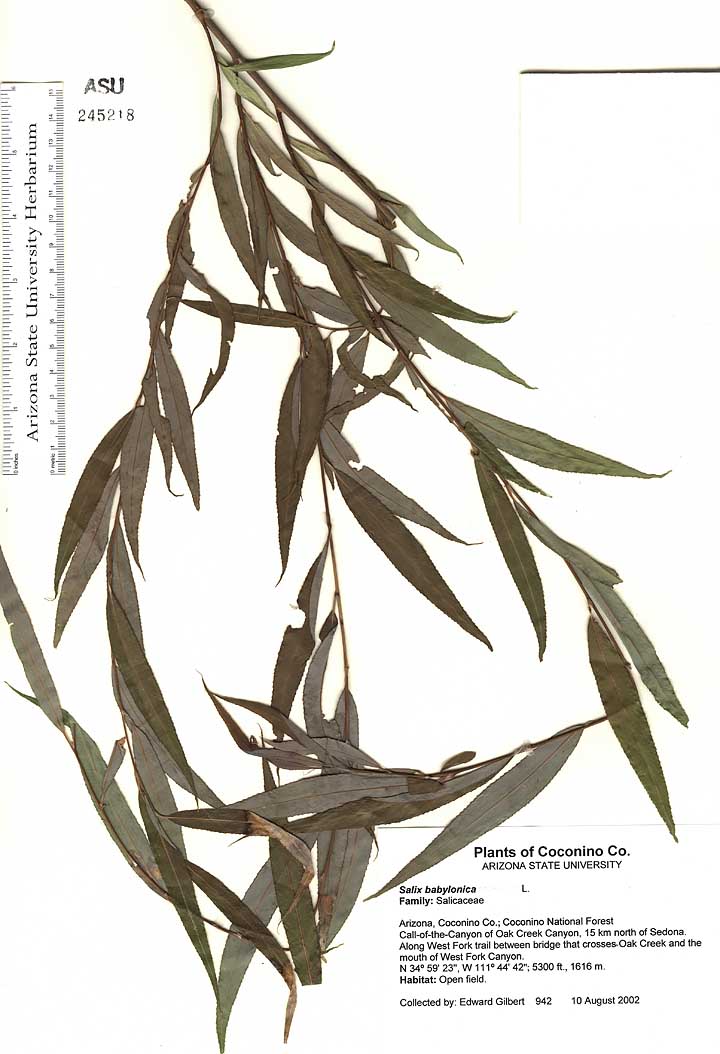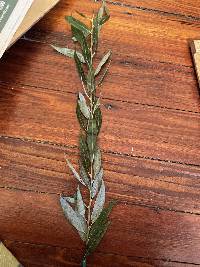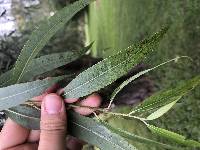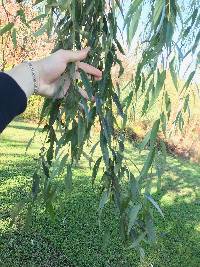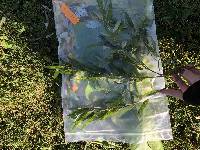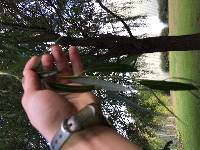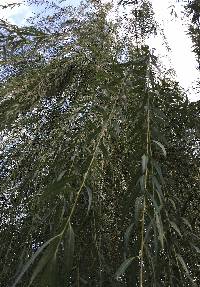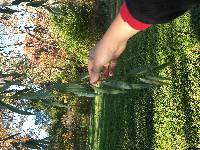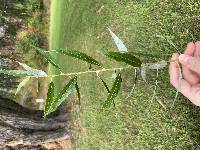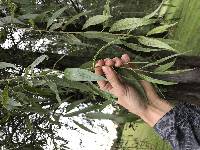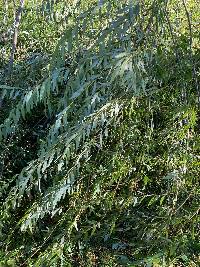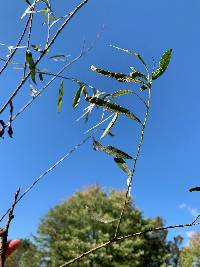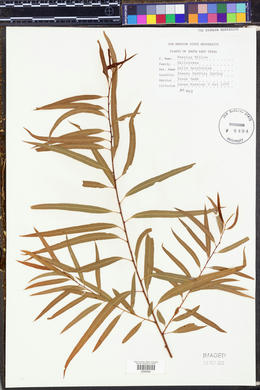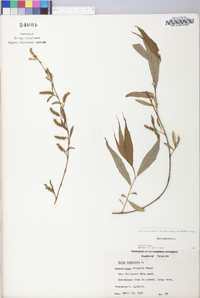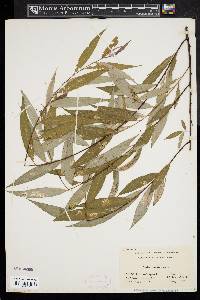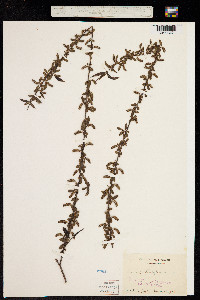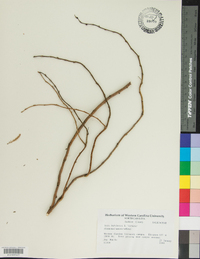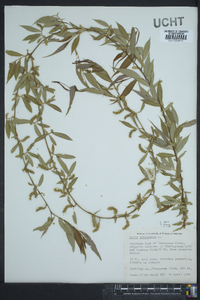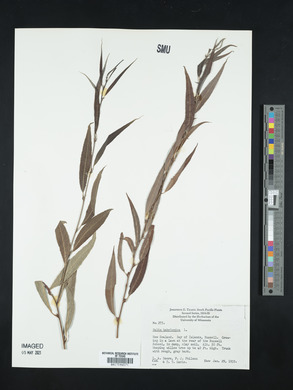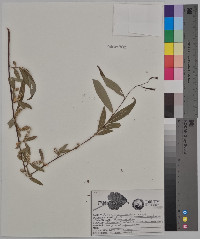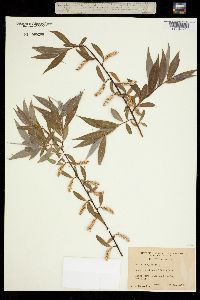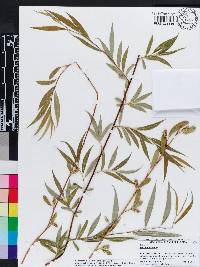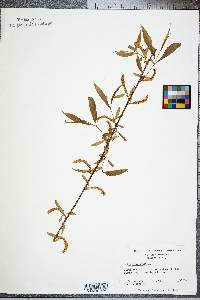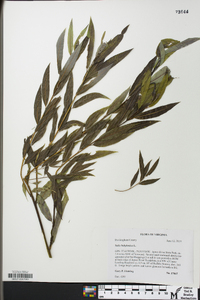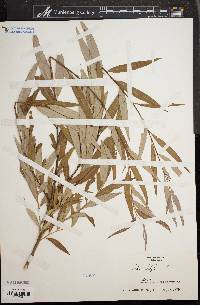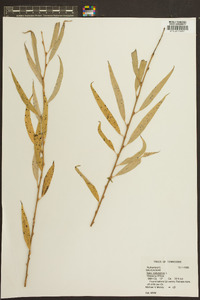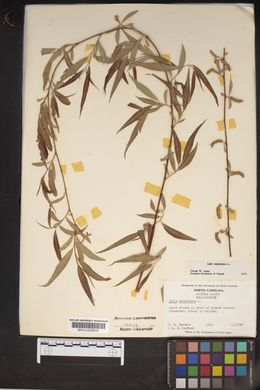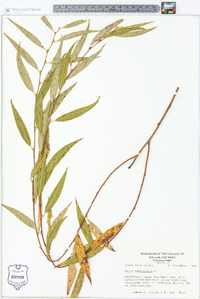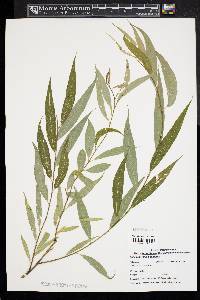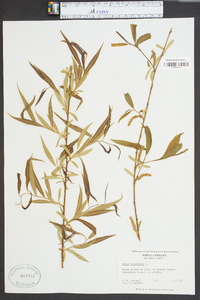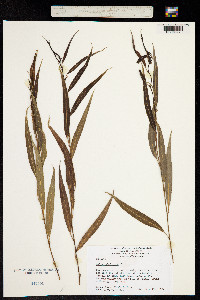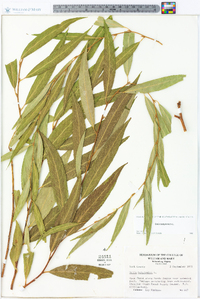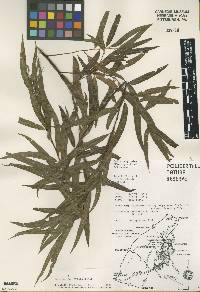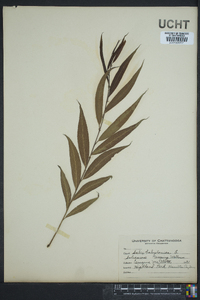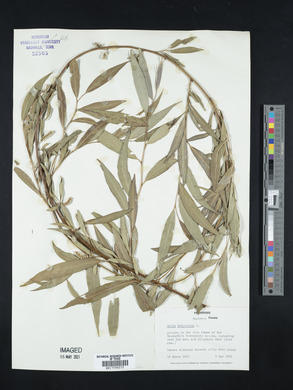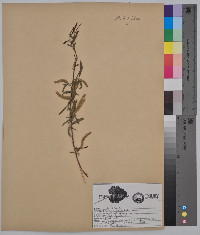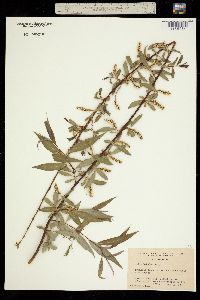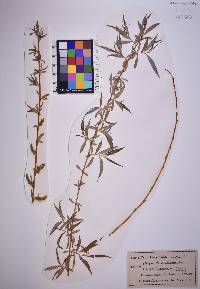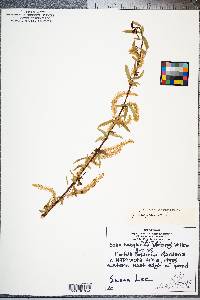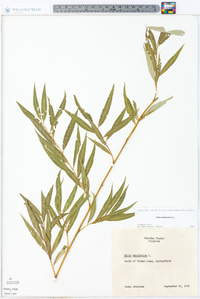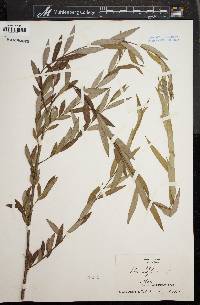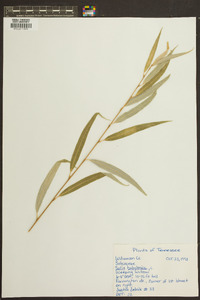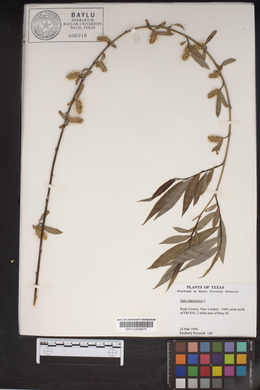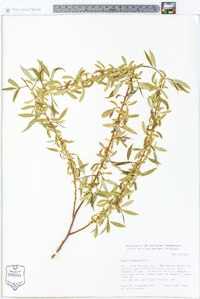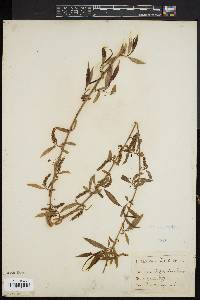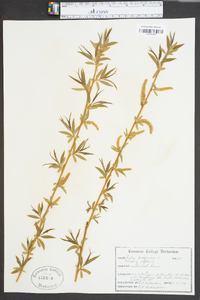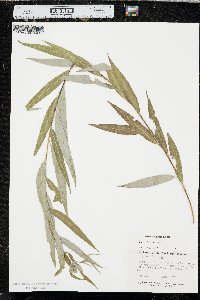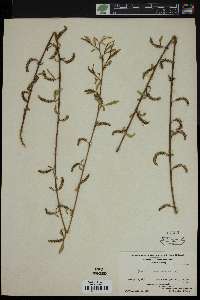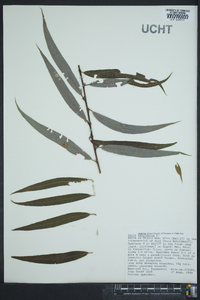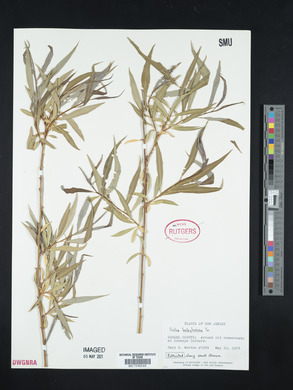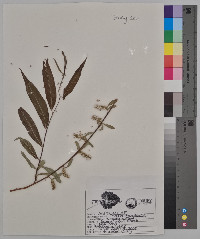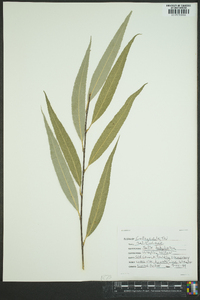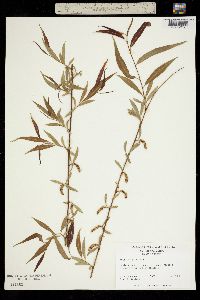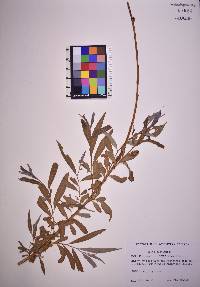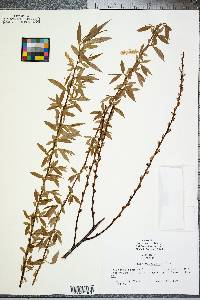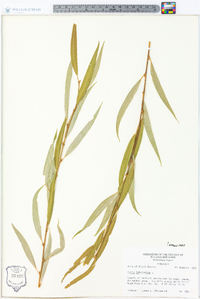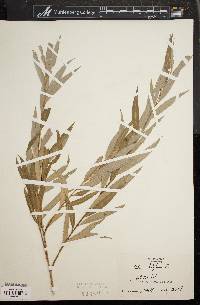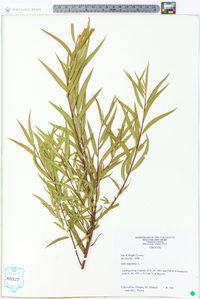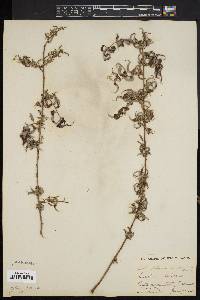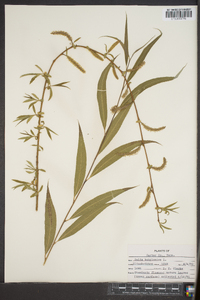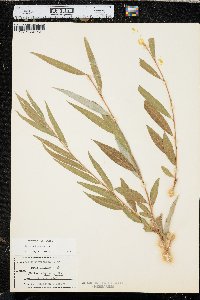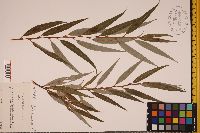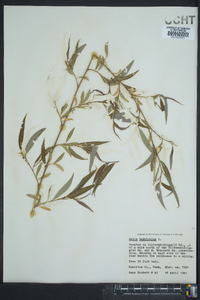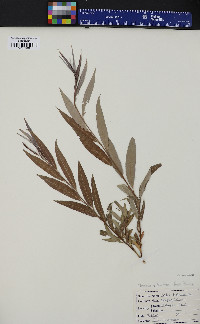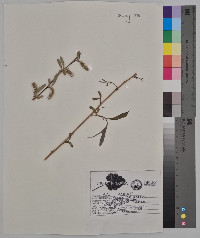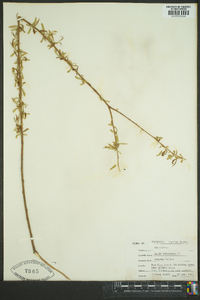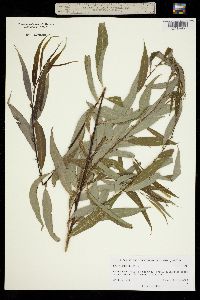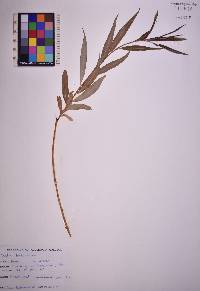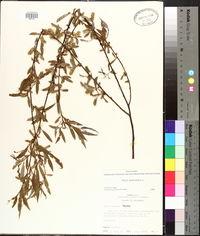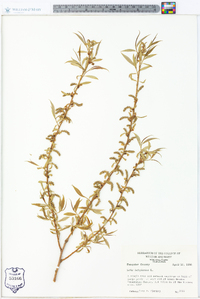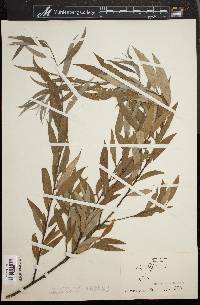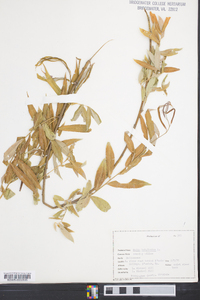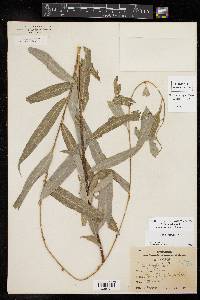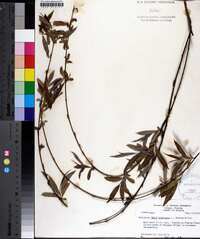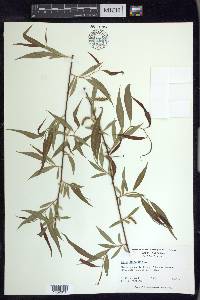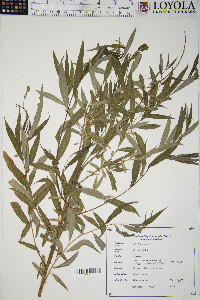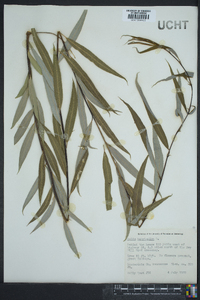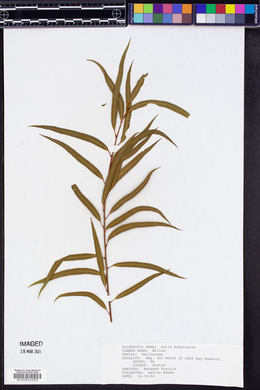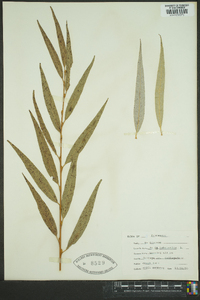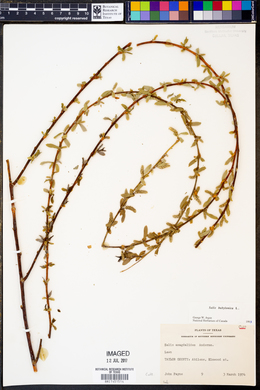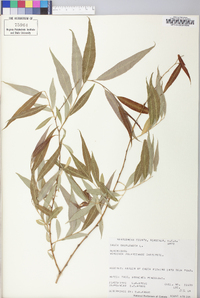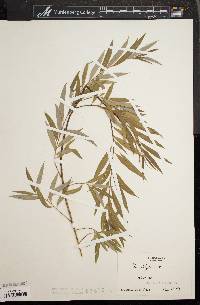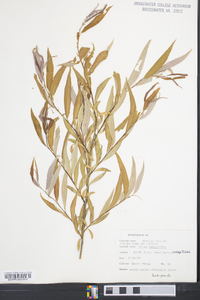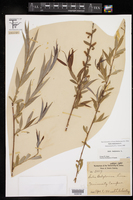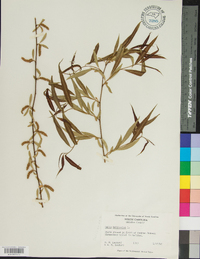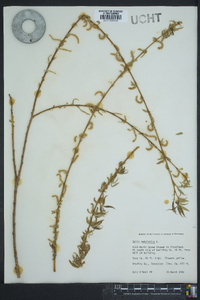Salix babylonica
|
|
|
|
Family: Salicaceae
Chinese Willow
[Salix babylonica f. pendula (C. K. Schneid.) Geerinck] |
Stems: branches yellow-brown to red-brown; branchlets sparsely to moderately densely tomentose, especially at nodes. Leaves: stipules absent or rudimentary on early ones; petiole convex to flat or shallowly to deeply grooved adaxially, 7-9 mm, tomentose abaxially; largest medial blade lanceolate, narrowly oblong, or narrowly elliptic, 90-160 × 5-20 mm, 5.5-10.5 times as long as wide, base cuneate, margins flat, spinulose-serrulate or serrulate, apex acuminate, caudate, or acute, surfaces glabrous or sparsely short-silky, hairs straight, dull adaxially; proximal blade margins entire; juvenile blade reddish or yellowish green. Catkins (flowering just before leaves emerge); staminate 13-35 mm, flowering branchlet 1-6 mm; pistillate densely flowered, stout or subglobose, 9-27 × 2.5-7 mm, flowering branchlet (0-)2-4 mm; floral bract 1.1-1.8 mm, apex acute, rounded, or truncate, entire, abaxially sparsely hairy throughout or proximally, hairs wavy. Staminate flowers: abaxial nectary 0.2-0.6 mm, adaxial nectary oblong or ovate, 0.4-0.7 mm, nectaries distinct or connate and cup-shaped; filaments distinct, hairy on proximal 1/2 or basally; anthers (sometimes reddish turning yellow), ellipsoid or globose. Pistillate flowers: adaxial nectary oblong, square, ovate, or obovate, 0.4-0.8 mm; ovary ovoid or obturbinate, beak (sometimes pilose proximally), slightly bulged below or abruptly tapering to styles; ovules 2-4 per ovary; styles distinct or connate 1/2 their lengths, 0.2-0.3 mm; stigmas flat, abaxially non-papillate with rounded tip, or 2 plump lobes (almost capitate), 0.2-0.3 mm. Capsules 2-2.7 mm. 2n = 76. Flowering spring. Around settlements; ca. 50 m; introduced; Ala., Ark., Calif., Del., D.C., Fla., Ga., Ky., La., Md., N.C., S.C., Tenn., Va.; Asia; introduced also in Mexico (Mexico City), South America. Little is known about the origin of the strongly weeping cultivar of Salix babylonica. It was described by Linnaeus (1737[1738]) based on young garden specimens (W. J. Bean 1970-1988, vol. 4). It is thought to have originated in China, although it no longer occurs in the wild and its origin is uncertain. Selections are thought to have been transported to Europe along the trade route from China. In Tajikistan, there are three cultivated clones, one of which is staminate (A. K. Skvortsov 1999). Taxonomic treatments of S. babylonica are variable. Some botanists recognize a single species, including both pendulous and non-pendulous forms (Skvortsov), while others recognize four species: S. babylonica, with a weeping habit, S. capitata Y. L. Chou & Skvortsov, S. pseudolasiogyne H. Léveillé, and the commonly cultivated S. matsudana Koidzumi (Fang Z. F. et al. 1999), with an erect or spreading habit. Here, S. babylonica is treated in a narrow sense, including only weeping forms. Salix babylonica is not cold tolerant and is not commonly grown in Europe (R. D. Meikle 1984) or in northern North America. In the flora area, cultivated trees with strongly pendulous branches and branchlets have been identified as S. babylonica (G. W. Argus 1985, 1986, 1993), but many are hybrids with S. alba (S. ×sepulcralis) or S. euxina (S. ×pendulina). Salix ×sepulcralis, especially nothovar. chrysocoma, with bright yellow branchlets, is the most commonly grown of these hybrids. All reported occurrences of S. babylonica need verification. Hybrids: Salix ×sepulcralis Simonkai: Weeping willow, S. alba × S. babylonica, is introduced from Europe and widely naturalized throughout the world. Synonyms include S. ×salamonii Carrière ex Henry and S. ×sepulcralis nothovar. chrysocoma (Dode) Meikle. It is characterized by: trees, to 12 m, stems pendulous; branches somewhat to highly brittle at base, yellowish, yellow-green, or yellow-brown; branchlets yellowish, yellow-green, or golden; stipules rudimentary or foliaceous on late leaves; petiole not glandular or with pairs or clusters of spherical glands distally or scattered throughout, short-silky adaxially; largest medial blade amphistomatous or hemiamphistomatous, narrowly elliptic to very narrowly so, margins finely serrulate or spin FNA 2010, Jepson 2012, Kearney and Peebles 1969 Common Name: weeping willow Duration: Perennial Nativity: Non-Native Lifeform: Tree Wetland Status: FACW General: Introduced, shrubs or trees, perennials, to 16 m tall, the wood soft, with solitary bud scales, stems flexible, pendent, yellow- to red-brown, young twigs and nodes sparsely to moderately densely tomentose, becoming glabrous with age. Leaves: Alternate, mature blades lance- linear, 90-160 mm long, tips acuminate, bases wedge-shaped, margins flat, finely sharp-serrate-spiny, surfaces glabrous or sparsely short-silky, hairs straight and dull above, young leaves glabrous to moderately densely silky, later stipules leaf-like, petioles 7-9 mm long, convex to flat or shallowly to deeply grooved adaxially, tomentose abaxially, usually with glands. Flowers: Perianths reduced to adaxial nectaries, staminate and pistillate; staminate flowers with 2 stamens, abaxial nectary 0.2-0.6 mm long, adaxial nectary oblong or ovate, 0.4-0.7 mm long, nectaries distinct or connate and cup-shaped, filaments distinct, hairy on proximal half or basally, anthers sometimes reddish turning yellow, ellipsoid or globose, pistillate flowers with 2 flat, plump-lobed stigmas 0.2-0.3 mm long, styles solitary, distinct or connate half their lengths, to 0.3 mm long, nectaries solitary, rod-like, the beaks sometimes pilose proximally, slightly bulged below or abruptly tapering to the styles, inflorescences of staminate and pistillate catkins; staminate catkins 13-35 mm long with flowering branchlets 1-6 mm long, pistillate catkins densely flowered, stout or subglobose, 9-27 mm long and 2.5-7 mm wide, flowering branchlets 2-4 m long, with leafy, tan colored floral bracts 1-1.8 mm long, the apices acute, rounded, or truncate, margins entire, surfaces sparsely hairy throughout or proximally below, the hairs wavy, 7-22 mm long. Fruits: Capsules with 2 valves, 2-2.7 mm long. Seeds often with a basal tuft of hairs. Ecology: Found near wetted areas, around settlements, around 150 ft (45 m); flowering in spring. Distribution: Scattered across the United States, found in the southwest in California, New Mexico, Texas, and Colorado. Ethnobotany: There is no specific use recorded for this species, however other species in the genus have many uses, including medicinal, food, and the construction of structures, furniture, baskets, and other items. Synonyms: Salix X pendulina, Salix X sepulcralis Editor: LCrumbacher2012 Etymology: Salix is a Latin name for the willow and meaning "to leap or spring" in reference to its fast growth, and babylonica comes from Babylonian, or having something to do with Babylon. Tree to 12 m, the cult. and escaped forms with long, slender, pendulous, olivaceous or yellow-brown, glabrous or subglabrous, basally brittle twigs; stipules lanceolate, 2-7 mm, or none; lvs lance-linear, 8-12 נ0.5-1.5 cm, mostly falcate, long-acuminate, finely but unevenly spinulose- serrulate, glabrous, yellowish-green above, ±glaucous beneath; petioles 7-12 mm, tomentose, often glandular above at the tip; catkins with the lvs, 1-2.5 (staminate to 4) cm, on peduncles 0.5-1.5 cm with 2-4 tiny lvs; scales pale yellow, crinkly-hairy, ±persistent; stamens 2; frs narrowly ovoid, 1.5-2.5 mm, sessile; style almost obsolete; stigmas brush-like (unique among our spp.); 2n=76. Native of China, sparingly escaped from cult. in our range. Gleason, Henry A. & Cronquist, Arthur J. 1991. Manual of vascular plants of northeastern United States and adjacent Canada. lxxv + 910 pp. ©The New York Botanical Garden. All rights reserved. Used by permission. |
|
|
|

